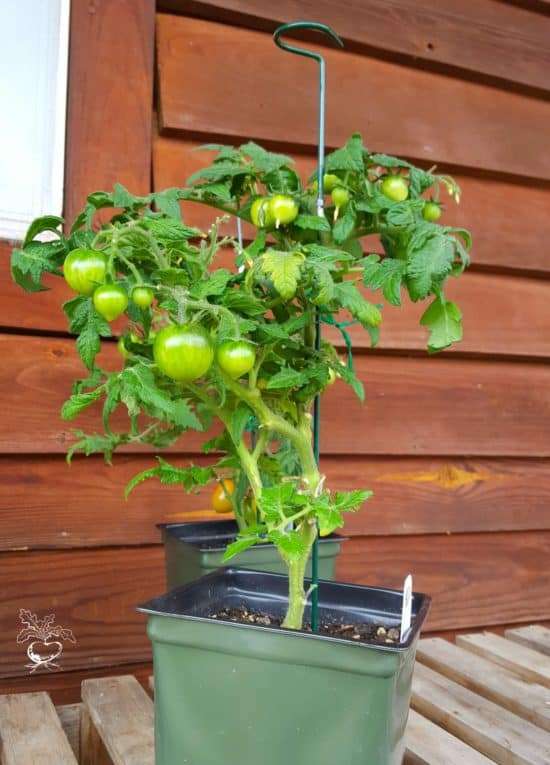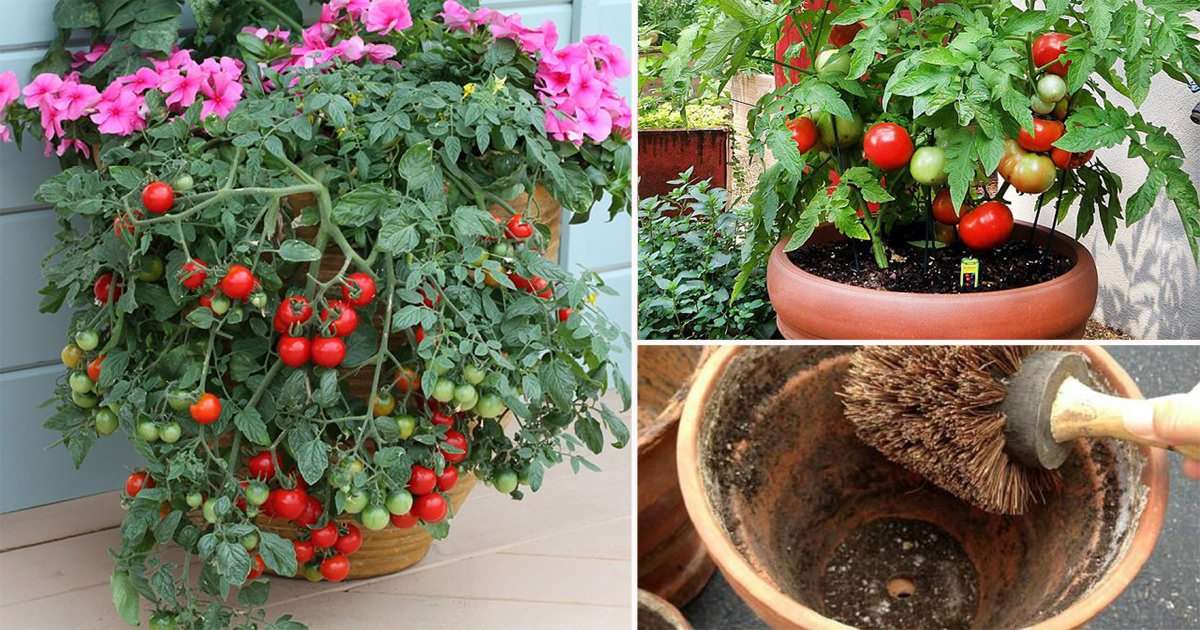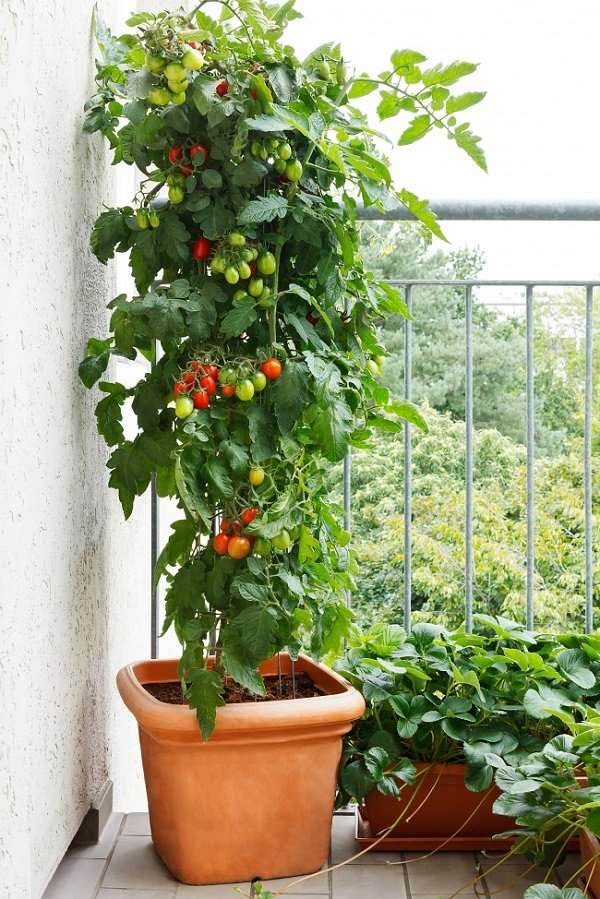Start With A Support System
All that growth needs support, so make sure that you place a tomato climbing frame or several stakes in the pot at planting. A common mistake is to put the stakes in after the plant has begun to grow, which can risk damaging the roots. As the tomato grows, tie it carefully to the stakes or frame. Use garden twine or pieces of pantyhose, but take care not to tie them so tightly that you damage the stems.
Water The Plants The Right Way
Water regularly to keep the soil slightly moist but not saturated. Always use your finger to determine the state of the soil before you water. Also, avoid overhead watering as shown in the picture above, because the wet foliage is more prone to fungal infection.
Also Read:How to Water Container Plants
How To Prevent Blossom End Rot
While adjusting feeding and watering rates to levels that encourage steady, moderate growth of the plant can somewhat reduce the occurrence of blossom end rot, it is difficult if not impossible to prevent it entirely, since garden conditions are so variable. There are several ways to prevent blossom end rot from happening in the first place.
Also Check: How To Remove And Install Sliding Patio Door
Sun Water And Fertilizer
Once you’ve selected the container and prepared the soil mix, put the container in a sunny location that receives six to eight hours of direct sun daily. In cooler climates, setting the pot next to a south-facing, wind-sheltered wall provides the warmer temperatures that tomatoes prefer. If you live where temperatures routinely rise above 90 to 100 degrees Fahrenheit, provide some afternoon shade with a shade cloth or bed sheets suspended over the plant.
Tomatoes require evenly moist soil to avoid blossom end rot and cracking. Check the soil daily and water as needed. Add a drip watering system or wind a soaker hose through the potted plants to make watering easy while you avoid wetting the foliage. A layer of organic mulch over the bare soil, pulled back from the stem, helps slow water evaporation from the container.
Harvest to Table recommends fertilizing container-grown tomatoes every two to three weeks with a water-soluble fertilizer. Alternatively, add a slow-release fertilizer according to the manufacturer’s directions. Generally, tomatoes thrive with a 5-10-5 formulation, which supports the growth of the fruits with plenty of phosphorus. Always water after fertilizing.
Best Containers For Tall Tomato Varieties

Tall, indeterminate varieties are best grown in pots at least 9 inches in diameter or grow bags. Using grow bag pots, also known as ring culture, is a very good way to grow tall varieties as they can be fed and watered through the different rings. Inner ring for feed, outer for water.
Below is a photo of pots with reservoirs, also known as self watering planters.More about containers for tall varieties.
Don’t Miss: Poggesi Umbrella Cost
Benefits To Growing Tomatoes In Pots Or Containers
Containers and pots are versatile. The beauty of growing tomatoes in pots is that nearly anyone can do it no matter if you live in a tiny condo, on a farm, in suburbia, or in a high-rise apartment with no patio. They work on a patio, porch, driveway, greenhouse, walkway, stairway, deck even in a sunny window. Pot size is not really a factor, either. You can find tomato varieties that flourish in small containers like quart pots. Or if you have more room, you can create an entire miniature vegetable garden in large barrels or anything in between.
Containers are portable. You can bring your containers inside temporarily if the forecast is too cold or too wet. Towards the end of the season, you can extend your tomato harvest by moving containers to a protected area or into the garage overnight.
Containers are useful in small spaces. You may not have room for a full-blown vegetable garden or even a tiny patch, but you can still enjoy fresh tomatoes for less money than youd spend at the farmers market or a roadside stand by growing them in containers.
Containers are convenient. Your schedule may not allow time to manage a vegetable garden. But it takes just a few minutes to plant tomatoes in containers and a few seconds a day to check on them. Harvesting is easier, too.
Containers Present Only One Or Two Challenges
The main challenge to growing tomatoes in containers is you have to be extra careful with watering. Containers are above ground. They dry out quickly so youll need to check the soil often.
Over watering can lead to problems, too, which you can take measures to avoid. Containers without drainage holes or proper drainage material in the bottom can make your tomatoes are vulnerable to root rot. Good drainage solves most over watering issues!
You May Like: How To Remove Sliding Patio Door Frame
How To Grow Tomatoes In A Container
Tomatoes are beneficial to our health in several ways. They are made up of about 90 percent water to help with hydration, while the other five percent contains lots of fiber.
One small tomato has only 18 calories but gives our body calcium, protein, and healthy carbs that help prevent cancer and support heart health. Follow some of the following tips to learn how to grow tomatoes in a container successfully.
Its possible to grow heirloom tomatoes from seed as well as seedlings, but it will take several weeks longer for the seeds.
Use The Right Technique To Plant
Unlike all other plants, tomatoes must be planted deeply. Deep planting encourages a healthy and strong root system. At the time of planting, cover the bottom 2/3 part of your baby tomato plant with potting soil. For example, if your plant is 10 inches high, leave only 3 or 4 inches of its height from the top.
Recommended Reading: Build A Pergola On An Existing Deck
How To Grow Tomatoes In Containers
Growing tomatoes in containers is often a very good choice where you have limited garden space or where the garden soil is less than ideal for growing tomatoes. Potted tomatoes can easily be grown on a deck or patio, or in railing or window boxes. There are three keys to successfully growing tomatoes in a container: choosing the right tomato variety, proper planting, and ongoing care. Pay attention to these three areas, and you’ll be in tomato heaven in no time.
Tomatoes are warm-season, slow-growing vegetables that take as much as 150 days to mature from seed, so in all but the warmest climates, they are usually planted from well-developed nursery starts in the spring after the soil has fully warmed. If started from seed, they need to be sown indoors several weeks before the last frost of the spring.
Tips For Growing Tomatoes In Containers
Tomatoes are one of the most satisfying vegetables to grow. Their juicy red sweetness is something that simply cant be topped. Growing tomatoes in containers means that fresh tomato harvests are accessible to everyone regardless of where you live.
From balconies, to patios, to fire escapes, to rooftops, you can grow tomatoes anywhere when you plant a tomato container garden. Follow these 13 tips for growing tomatoes in containers.
You May Like: How To Build A Hip Roof Patio Cover
Choose Varieties That Mature Early
Early maturing cultivars are great for container gardeners. Varieties like Moskvich, Golden nugget cherry, and Glacier cherry tomatoes are some good options that take around 55-60 days to mature.
- Bloody Butcher can be harvested in 50-60 days.
- Stupice are small tomatoes, taking 50-60 days to mature.
- Sub Arctic Plenty tomatoes grow 2-3 inches in size and mature in 50-55 days.
- Sungold is a cherry tomato that ripens in 50-60 days.
- Moskvich is a Russian variety that can be harvested in 60-65 days.
- Betalux is a determinate variety, taking 50-60 days to mature.
- Glacier produces 2-3 inches of fruits in 55-60 days.
- Siberian is an early tomato variety you can harvest in 60-65 days.
Caring For Tomato Plants

You May Like: Metal Outdoor Furniture Vintage
Growing Tomatoes In Pots: Favorite Hybrid Indeterminates
- Carmello: Reliable and prolific, with intensely flavorable, 8 oz., juicy red fruits. Disease resistant and a great overall main-season tomato which produces good flavor even during the colder part of the season.
- Sungold: Sweet, prolific and very popular cherry tomato. Most cherry tomatoes will do well in containers, as they grow tall but their fruit is small and they dont tend to sprawl as much.
Building A Home Hydroponics Container Garden
Here is a list of needed tools and materials:
- 1 plastic bucket or flower pot,
- A length of hose about 1/2 inch in diameter,
- 1 barbed water outlet fitting sized to fit the hose diameter you have selected or one plastic spigot sized to your hose diameter, with a screww nut,
- 1 tube of silicon gel ,
- 1 clip or something similar such as clothespins to crimp the hose if you are not using a spigot,
- 1 rubber washer that fits over the water outlet fitting or spigot on the inside of the bucket,
- 1 drill with bit sized to your water outlet fitting or spigot.
To build this system do not be put off by the directions, anyone can do this and Im living proof. Below is a picture of the clip I use to crimp the hose and the silicon used.
After gathering the needed tools and materials, drill a hole into the bottom side of the plastic container about an inch from the bottom. Make sure you position the hole a little bit off the bottom so as to leave room for the spigot and rubber washer.
It may be easier to drill if you place a board on the inside of the plastic pot resting against the section you are drilling into so the plastic does not buckle making it hard to drill.
Insert the spigot into the hole from the outside and on the inside of the pot, coat one side of the rubber washer with a generous coating of silicon, and place the washer onto the spigot or water fitting so the silicon side rests against the side of the pot.
Recommended Reading: What Size Umbrella For Rectangle Patio Table
Vegetables For Container Gardens
When choosing vegetables to plant in containers, look for bush or small varieties , and ensure that your climate has enough growing days for the required time to mature.
Plants that typically grow well in containers include:
- Peas: Put tall supports in the container when planting seedlings. Water frequently, and keep them fertilized.
- Potatoes: Some potatoes need a 120-day growing season, so look for varieties that mature early.
- Tomatoes: Like peas, tomatoes need a support system. Use a rod or tomato cage to keep your plants upright.
- Carrots: Use a container that’s double the depth your variety will grow.
- Radishes: Containers don’t have to be that large for this spring and fall vegetable.
- Eggplant: When planning which variety to buy, know that many eggplants are fairly sensitive to cool temperatures .
- Summer or zucchini squash and cucumbers: Choose bush varieties rather than the sprawling vine varieties. One plant can fill a 24-inch pot quickly, so don’t crowd your seeds or seedlings. A trellis in the pot will supply support for the fruit and allow air to flow around the plant.
- Leafy greens: Spinach and leaf lettuce are among the many greens that you can snip to eat one day and then snip again a few days later. Grow the cool-season crops in spring or fall. They also tolerate partial shade.
- Peppers: Try traditional bell peppers, or spice it up with hot peppers that are perfect for homemade salsa.
Plants that don’t usually work well in containers include:
- Large melons
What Size Pots Do Tomatoes Need To Grow How Deep
Tomatoes are vigorous growers that need lots of room for roots to spread out. Containers should be at least 5 gallons or 12 inches wide and deep, though bigger is better. For maximum production, containers that are 10 gallons or larger are ideal, especially for bigger tomato varieties. Ceramic or plastic pots will retain moisture better than terra cotta. Make sure there are adequate drainage holes in the bottom.
For a decorative touch that also makes growing tomatoes easier, try Proven Winners®AquaPots®. These high-quality self-watering pots deliver a constant source of water while providing plenty of room for tomato plants to grow and thrive.
Read Also: How To Arrange Potted Plants On A Patio
How To Grow Beefsteak Tomatoes In Pots The Ultimate Guide
Growing beefsteak tomatoes in pots is one of the easiest ways to start container gardening. And a container garden helps you to maximize your available space.
Beefsteak tomatoes are one of the most popular tomato varieties they also produce very large fruits that weight about 2 pounds. Moreover, they are relatively easy to grow.
They come in vibrant red or pink color, and better yet, they are quite juicy.
And growing beefsteak tomatoes in pots means that you dont really need a large portion of land to do so. It also means you can start your own small container garden in your backyard or grow beefsteak tomatoes indoors.
Soil Mixes For Tomatoes
Whether you’re growing cherry tomatoes in pots or beefsteaks, you need to provide a loose, well-drained mix. Potting mixes are readily available at retailers and garden centers, but you can make your own potting mix at home. The University of New Hampshire Extension recipe for a tomato potting mix incorporates equal parts vermiculite and peat moss plus lime, superphosphate and 5-10-5 fertilizer. You can also add compost to the mix.
If weight is not an issue, you can also make a soil-based potting mix by mixing equal parts garden soil, compost and coarse sand plus a slow-release fertilizer formulated for tomatoes. A heavier soil-based mix may combine four parts garden soil plus one-and-a-half parts sphagnum moss and coarse sand and one part well-decomposed manure. If your soil is a heavy clay or is sandy, reduce the amount of soil in the mix and increase the amount of compost to improve drainage and add nutrients.
Don’t Miss: How To Paint Wrought Iron Patio Furniture
How To Grow Roma Tomatoes In Pots
Today we discuss How to Grow Roma Tomatoes In Pots, Balconies, and Backyards
Introduction to Roma Tomatoes:
The Roma tomato will be sweet and plump which is popular for its less content of water and chewy internally. It is mostly used for making tomato paste and for the purpose of canning. In order to grow Roma tomatoes, you need to first bring the seedings and choose a location which is sunny. You have two ways to grow Roma tomatoes. You can start growing Roma tomatoes in pots and you can also grow them in your garden beds. After completion of the first frost date, keep your Roma tomato in a pot or in a hole, cover the pot with soul and keep watering it for every 2 or 3 days. By putting a little effort, you can grow Roma tomatoes in a simple manner. Now, let us get into how to grow Roma tomatoes in pots.
Soil requirements:
The soil which is most suitable for growing Roma tomatoes is the one which is well drained, loamy and light. The soil should be rich in terms of organic matters such as compost, manure, and humus.
Growing Roma Tomatoes in pots
Maintenance of the Roma Tomato plants:
The problem of pests:
Ripening of Roma tomatoes:
How To Grow Tomatoes In Pots

After you find the perfect plant, it is time to plant it. In general, plastic or fiberglass pots are best for growing tomatoes for a few reasons. Plastic and fiberglass, unlike clay pots, don’t dry out quickly, and while tomatoes love heat, they don’t like being dry, and dry soil is a huge detriment to fruit production. Tomatoes need to grow in a reasonably large potat least 8 inches deep and preferably 12 to 16 inches. Plastic is inexpensive, even for huge pots, and it’s unlikely to break the way clay so often does. For a cheap option, you can plant tomatoes in a five-gallon bucket . They are the perfect size, and the price can’t be beaten.
After you have the perfect pot, make sure that it has adequate drainage the tomato plant will rot if it is sitting in soggy soil all the time. Most purchased pots have drainage holes in the bottom already, but if you’re using a five-gallon bucket, drill several holes in the bottom. If the pot you are using has large drainage holes, use a piece of a broken pot, a piece of window screening, or a paper coffee filter to cover it. This way the water can drain out, but the soil won’t end up all over the patio.
Read Also: Old Fashioned Metal Patio Chairs